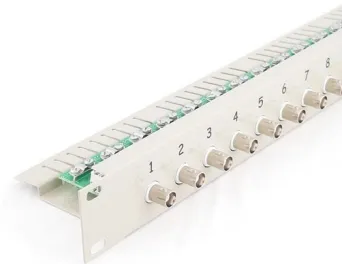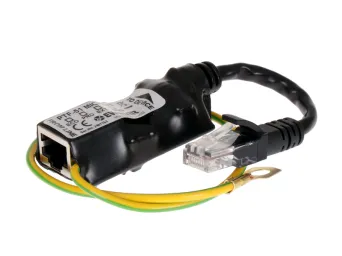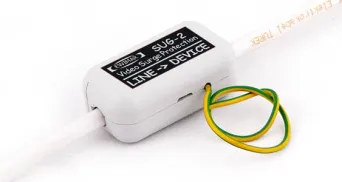What is important during installation?
When designing and installing a surge protection system, keep the following guidelines in mind, which are important for their proper operation during an electric discharge.
1. Checking the threat level
When selecting a surge arrester to protect devices, one should take into account not only the place of their installation, but also the wiring path. The device can be installed inside, but when a part of the cable runs outside the buildings or in the vicinity of other cables that may be a source of danger, a dedicated arrester should be used for devices installed outside.
2. Maintaining the distance from the lightning rod
Keep the protected device as far as possible from the lightning rod and its cables. During a direct discharge, the ground is unable to absorb all the energy and some of it spreads out in the form of spark overs. The distance allows you to maintain a natural barrier against the penetration of large loads into the protected device. If the device is installed on the roof and the lightning rod wires are on par with the device, it is necessary to extend them. Otherwise, a direct discharge to the device can occur, which cannot be eliminated even by very effective SPDs.
3. Proper grounding
The surge arrester becomes fully operational when the ground is connected, because only then the load can be fully discharged to earth. The standards do not provide the required value of the ground electrode resistance for SPD, because the value of the surge current is incomparably lower than in the case of a lightning protection installation. However, it should be ensured that the grounding resistance is as low as possible and that the grounding electrode is as close as possible to the arrester, which will allow for its quick activation. The grounding wire should not be run in close proximity to the lightning rod and along it, due to the generation of a large electromagnetic pulse. Local grouning should be located as far as possible from the lightning rod earthing point. Never connect the grounding to the lightning rod line - due to high energy, it will reverse the strike from the lightning rod to the protected installation. In case of protection of devices installed inside the building, it is best to connect the grounding of the arresters to the PE line.
4. Selecting the grounding wire
The atmospheric discharge is a very short pulse which causes a skin effect in the wires. To reduce the resulting impulse resistance and increase the efficiency of discharge of the load to the ground, a stranded cable should be used. The grounding cross-sections of the conductors to the SPDs are subject to different properties than the PE conductors used for protection against electric shock due to the short duration of the impulse.
For surge arresters intended for protection of devices installed inside buildings, a wire with a cross-section of 2.5mm² is sufficient.
Single surge arresters installed outside, with impact efficiency up to 15-20kA, should be used with cables with a cross-section of at least 4mm².
When multi-channel arresters are installed in RACK cabinets, the total surge current can be high, therefore we recommend the cross-section of the grounding wire at least 10mm².
5. Ensuring good quality of connections
Both the grounding cables connections and all connections on the endangered side should be very solid. Improper contact will cause the contact point to overheat and even burn out. This carries a risk of improper operation of the arrester and failure of the protected device.
Avoid installing additional devices and thin wires (patch cords), between the signal cable and the surge arrester. An example is the installation of standard patch panels with LSA (Krone) connectors between the LAN cable and the arrester with a shock strength above 250A. For such a solution, a patch panel with Keystone connectors should be used.
6. Placing the arrester close to the protected device
To minimize the risk of an overvoltage induction in the wire from the surge arrester side, it is recommended to use the shortest possible connection between the surge arrester and the protected device. The length of the connection cable should not exceed 50 cm.
7. Securing the two ends of the cable
The electromagnetic pulse is induced along the entire length of the cable. The induced voltage propagates to each side of the cabel, which causes the voltage to appear along its entire length. The use of the arrester on one side only causes a temporary effect of the overvoltage on the unprotected device on the other side of the cable. Before the arrester will eliminate a threat, it may be damaged. It is recommended to use protectors on both ends of the cable and to ground them.
8. Not reversing the operation of the arrester
The vast majority of combined SPDs have a directional action - they have the endangered side, which receives a high-value surge current, and the protected side, to which the protected device is connected. Reversing the connection may damage the arrester during discharge and damage the protected device.
Entire content of this article together with photos is the property of Ewimar Sp. z o.o. and is legally protected. Prohibition of copying and sharing in part or in whole, or use in publications and public presentations.




